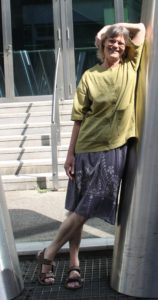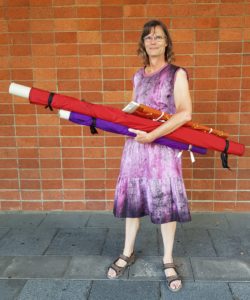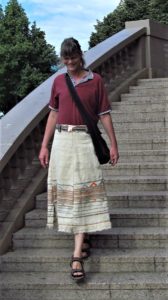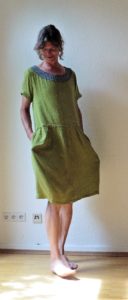In the last two years I have gone through a transformation, as a result of which I now experience and define myself as a woman. Two women whom I am very fond of interviewed me about this transformation process in August 2021. The second part of this interview is reproduced here. The questions (except for the last one) in this part were posed by Franziska Fendesack and address clothing and creativity. Franziska Fendesack has devoted virtually all of her professional life to clothing technology. She is a master tailor, has studied textile management and has worked several years in Hong Kong. Next to her full time work as team leader in technical product development at a fashion brand she also works as a consultant for women who are starting businesses in the textile industry.
Franziska: It’s fascinating what we have heard so far from you, Wiltrude, about your change, transformation, becoming yourself, the best version of yourself as you said. I remember when we first met at the Transition House. The entrance door opened, and there you stood, you had a blue skirt with an Indian pattern. You stood there so matter of factly and were clearly a man wearing a skirt! I just thought, this is going to be interesting! And I still think so!
I would like to ask you a few questions explicitly about your clothing style. You experienced a change of identity in the last few years that you express through your style of dress. How did you experience the several phases of becoming a woman, what did that mean for you, what made that possible, and can you remember specific pieces of clothing that accompanied and made visible this transformation?
W: Yes, as I had mentioned, it began with the clothing swap from which I obtained several pieces of clothing. There is for example a maroon colored skirt that I continue to enjoy wearing and that fits me exactly, a lucky chance! I can go cycling with it, and I went on a dyke march with it in 2019, in the middle of that there was a thunderstorm and we all got drenched! It started with things like that, which I found in the clothing swap and that more or less fit me.
Then I began to modify some things, such as a few things from the clothing swap that didn’t really fit me. Out of those I created some different things. Those were not the first things I ever sewed – I have sewed for a long time, sometimes I repaired some pieces of clothing. One time I even sewed a costume for Mardi Gras in New Orleans from some cloth from India, which I wore for that occasion. But then I didn’t have any other occasions to wear it again.
I never wished to sew pants or shirts though. Nowadays, because I can immediately and often can wear the skirts or dresses that I sew, I have much more motivation. Once I had begun, I also wanted to have more items of clothing, especially skirts. At the time being I can’t afford to just go shopping, and it’s much cheaper to buy a piece of cloth and to make a skirt out of it! Also, then I can make exactly what I want to have. Certain shops, like Delta Fabrics in Mannheim, obtain their fabrics from ecologically responsible sources, at least most of them. So there I don’t need to worry as much about how it was produced, what the ecological footprint is. I can select a fabric that I like and then create a skirt or dress that fits me exactly. That carries a whole different energy when I wear it. And I really enjoy sewing, otherwise I wouldn’t do it! Altogether that leads me to making my own pieces of clothing.
With every piece of clothing that I make, I learn something new, other techniques, or how to treat this kind of fabric, and so it evolves onward.
F: I also think that it makes a definite difference whether one buys something ready made in a shop or whether one gives form to one’s own vision with one’s own hands by one’s own agency. I am certain that this is a big difference. Every time that I see you in something you made, I think you are so proud of what you created for yourself, fantastic! Surely this is part of what helped you overcome your depressions, that you stand up and care for yourself!
I would like to turn to another question, which is one of your important topics, that is social, ecological and economic sustainability. You just mentioned it. If you sew your own pieces, when you obtain the materials where you can follow where they come from, then you don’t have to worry so much how this piece was produced. The topic of sustainability is omnipresent for you. In which ways do sustainability, sociology and economic sustainability play a role for you in regards to the clothing that you wear?
W: Yes, I do think a lot about how clothing is produced and consumed. That is closely connected. Thoughtless consumption promotes production methods that are harmful for the environment, for the sewing workers in Bangladesh or elsewhere, and everything that is connected.
Nowadays there are more and more businesses in the textile and garment industries that try to establish commodity chains that are socially and ecologically responsible from beginning to end. An example is Marketplace India. That was started by two Indian women who live in the USA, who design clothing for the American market together with women sewers in Mumbai and surroundings. The garments are then manufactured by cooperatives of women sewers. They make beautiful pieces. I think that we need to support such things, and this is only possible if we really think about what we buy. If one doesn’t buy a new piece every week, but rather buys things a bit less frequently but spends more on each piece. And thinks about what do I buy, what do I really need – so I look good in it, so it’s practical, and so I can wear it a long time. Then one can spend more money on each piece. This is about consuming with awareness.
If one doesn’t have much money, or if one enjoys it, one can also think about producing more oneself. Then if possible one buys the sustainably produced fabric, and puts a lot more thought into what one makes, what one wants to wear, what expresses one’s own personality, and what one wants to wear for a long time.
One can put that succinctly as putting more thought into each garment.
F: Superb! And I really have the impression at each of our meetings that you practice this to perfection, that you devote a lot of thought into what you do, what the story is behind each piece. Some of your pieces you also upcycle after all.
Are there any particular stylistic eras or specific styles that inspire you?
W: Well, for one I just experiment, look around at what is worn around me. Or for example once I bought a used top that I like very much, and that I continue to wear, and then I made another similar one from linen in emulation of that one. I see models all around me.

Regarding eras, I’d rather say that I feel inspired by the clothing that is being worn today in India, or what men in West Africa wear. In India, there are kurtas and all kinds of different garments with interesting cuts. Some of the cuts don’t differ that much between garments for women and men. The colors are often very different, but what the men wear to weddings often doesn’t differ from women’s wear that much even in the colors. That piece that I made for Mardi Gras years ago was based on Indian garment styles. I don’t have that piece any more, at one point I threw it away because I didn’t have any occasions to wear it!
About West Africa I like the robes that men wear there, the cuts and the colorfulness. That I find inspiring.
F: Yes, I also have that impression every time I see you. It’s not just that you are quite clearly a man in women’s clothing, but also you don’t hide yourself by wearing inconspicuous or black or white colors. On the contrary you are somebody who revels in colors and uses them to communicate. Now also, you are wearing a beautiful red silk top – what you wear can explode! I find that wonderful to see, you are like a butterfly that spreads its wings in the most flowering colors.
Apart from that, you once mentioned that because you have a body that is seen as male, your femininity requires special emphasis. How do you achieve this impression to the outside, or do you have a feeling of femininity through your dress, specific cuts or materials?
W: For one thing, if a woman wears pants, she is still a woman and is perceived as a woman. If I wear pants, I am immediately seen as a man.
F: It depends on the cut of the pants!
W: Yes of course. The pants that I wear these days are women’s pants, and I like to wear those a lot. They fit me much better than the jeans I used to wear. I always had problems finding jeans that really fit me. With women’s pants that are a bit loose and are made of soft fabric, that is no problem at all. But I do want to make it a bit more obvious, that I am wearing women’s clothes, for example by wearing skirts or dresses. And also handbags. It took me a while to turn to handbags, but recently I have made my second one.
F: Yay!
W: I think gradually I am going to make more accessories. That’s also a way to make use of remainders of cloth!
F: Absolutely!
W: Those are pieces of clothing that are obviously feminine. Or I wear a pink and black dress that I recently sewed. That is a color that is seen as feminine these days. A hundred years ago, that was a masculine color! That’s totally arbitrary. One communicates in the language that is spoken today in the place where we live. And here and now, pink is feminine! So I like to experiment with colors, see whether it suits me and whether I enjoy it, and so then I do it!

F: And that it definitely appears to do! Do you have any specific sources of inspiration that you use for your expressions in textiles?
W: One important thing is the variety of fabrics. As an example, there is the skirt that I made from a poncho. It’s a handwoven fabric, the yarn is rather thick, the material is heavy. It’s very different to work with this fabric than with much finer machine-woven fabric. It was an experience to see, what can I make with this material? That was a bit more difficult, but I worked out a result that I really like. So, it inspires me to engage with fabrics, what can one do with this or that fabric? What can one do with silk, or with linen, etc.? If I had some thought about a piece of clothing that I wanted to make, but then got a fabric that is not really suited for this design, then the design changed! I find that exciting!

F: Now we have talked a lot about what your clothing means regarding your identity, your expression, your playing field about textiles, but what function does clothing have for you in the end?
W: Of course it has the simple function to protect us from rain or sun etc.! But obviously we wear it for much more than that. Otherwise we would be able to walk outside naked if the weather is nice!
F: Or in a potato bag!
W: Yes!
Clothing is also self expression, an expression of the social role that one plays. If one works in a bank, one has to wear something different than if one works at a theater ticket counter. Clothing is an expression of many different aspects of oneself, and of cultural belonging, such as to which culture or religion one feels part of. And so clothing is a means of communication.
F: Absolutely! And I have the impression that you are now very free in your style. You wear items of clothing of which one strongly notices that they are very individual, and that you won’t be put in a box. Except by reference to obviously feminine or masculine clothing – that it is not masculine. I find that very exciting! In that context, what connection is there for you between creativity and femininity?
W: As I mentioned before, I find masculine clothing boring, and so I was not inspired to sew as long as I wore men’s clothing. I just find the variety of forms and colors and cuts that one can make with women’s clothing much richer, and so I find it much more enjoyable to make women’s clothing. I could imagine though, if there are men who like to wear skirts or dresses, that I would like to sew something for them. If more men are interested in this, to discover something, to try things out, then I would like to help them!
F: I hope the world hears this offer!
Can you describe to me how your creative process flows from the inspiration to the final piece of clothing?

W: I’ll take as an example the green summer dress that I recently made, because I had no real summer dress! What kind of a cut do I make? I had made a top from a book recently, and that seemed fitting to me for the top portion of the dress. With that, I wanted to have a skirt portion that hangs loosely, with interior pockets. For that, I thought I’ll make a square cut that I pull together a bit at the top. I found a beautiful green muslin fabric, which is incredibly soft and feels comfortable on the skin and is very airy! For the pockets I used sleeves which I had once cut off from an Indian shirt. I was able to use additional fabric remainders for the neckline. So now I have this wonderful summer dress!
F: And it suits you very well! Thank you very much for the interview!
Jane: Yes, thank you for this fascinating perspective. In this connection or beyond, what does fashion mean for you generally, in a society or for each person? What role can fashion play in societal change?
W: Well, if one speaks historically, fashion once was what was worn at the French court, and which was then transported to the rest of Europe. Fashion was created at a particular place, and then everybody else followed that. The conception of fashion obviously evolved enormously since that time, there are various fashion centers, fashion for the haute couture, fashion for the more normal people and so on. My vision would be that fashion continues to evolve to something that really develops bottom up. That often happens after all, as when some trends from the Hip Hop scene are picked up for example. But I don’t hope that such trends are picked up by some big fashion labels in order to make huge profits, but that fashion becomes something that continuously arises from the people. That they develop new things for themselves, create new trends and modify them, so that there is no centralized development of fashion, but that it emerges everywhere and creates new modes of expression.
Jane: That is fascinating how you combine all these discourses to create an entire vision of the future! I find it very exciting to hear what all flows together in your presentation!



